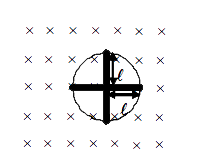The spokes of a wheel are made of metal and their lengths are of one metre. On rotating the wheel about its own axis in a uniform magnetic field of 5×10−5 tesla normal to the plane of the wheel, a potential difference of 3.14mV is generated between the rim and the axis. The rotational velocity of the wheel is-
63rev./s
50rev./s
31.4rev./s
20rev./s
The correct Answer is:d
Step by step video, text & image solution for The spokes of a wheel are made of metal and their lengths are of one metre. On rotating the wheel about its own axis in a uniform magnetic field of 5xx10^(-5) tesla normal to the plane of the wheel, a potential difference of 3.14 mV is generated between the rim and the axis. The rotational velocity of the wheel is- by Physics experts to help you in doubts & scoring excellent marks in Class 12 exams.
Updated on:21/07/2023Topper's Solved these Questions
- ELECTRO MAGNETIC INDUCTIONBOOK - MOTIONCHAPTER - ELECTRO MAGNETIC INDUCTIONEXERCISE - EXERCISE-2 (Objective problems (Analytical questions))
70 Videos
- ELECTRO MAGNETIC INDUCTIONBOOK - MOTIONCHAPTER - ELECTRO MAGNETIC INDUCTIONEXERCISE - EXERCISE-3 (Assertion & Reasoning)
18 Videos
- ELECTRO MAGNETIC INDUCTIONBOOK - MOTIONCHAPTER - ELECTRO MAGNETIC INDUCTIONEXERCISE - QUESTION FOR PRACTICE
41 Videos
- Electrical Instrument BOOK - MOTIONCHAPTER - Electrical Instrument EXERCISE - EXERCISE -3
16 Videos
- ELECTRO MAGNETIC WAVES BOOK - MOTIONCHAPTER - ELECTRO MAGNETIC WAVES EXERCISE - EXERCISE - 3 (SECTION - B)
8 Videos
Similar Questions
When a wheel with metal spokes 1.2 m long rotates in a magnetic field of flux density 5×10−5 T normal to the plane of the wheel, an e.m.f. of 10−2 V is induced between the rim and the axle. Find the rate of rotation of the wheel.
View SolutionWhen a wheel with metal spokes 1.0 m long is rotated in a magnetic field of flux density 2×10−4 T normal to the plane of the wheel, an emf of π×10−2 V is induced between the rim and the axle. Find the rate of rotation of the wheel.
View Solution
Knowledge Check
A rod of length l rotates with a uniform angular velocity omega about its perpendicular bisector. A uniform magnetic field B exists parallel to the axis of rotation. The potential difference between the two ends of the rod is
ABl2ω2BzeroC(Bl2ω8)D2Bl2ωA circular copper disc of radius 25 cm is rotating about its own axis with a constant angular velocity of 130rad/s . If a magnetic field of 5×10−3 Tesla is applied at right angles to the disc, then the induced potential difference between the centre and the rim of the disc will approximately be __
A20×10−3VB20×10−6VC20×10−9DZeroA rod of length l rotates with a uniform angular velocity omega about its perpendicular bisector. A uniform magnetic field B exists parallel to the axis of rotation. The potential difference between the two ends of the rod is
AzeroB12ωBI2CωBI2D2ωBI2
A rod of length l rotates with a small but uniform angular velocity ω about its perpendicular bisector. A uniform magnetic field B exists parallel to the axis of rotation. The potential difference between the centre of the rod and an end is
View SolutionA wheel is rotating with uniform angular velocity →ω. What is the nature of the graph between tangential speed at different points of the wheel and their radial distances from the axis?
View SolutionA conducting wheel in which there are four rods of length 25 cm as shown in the figure is rotating with constant velocity 20 rad/s in a uniform magnetic field 8 T . The induced potential difference between its centre and rim will be

View SolutionA constant resultant torque rotates a wheel about its own axis. Then true statement of the following is
View SolutionA conducting wheel in which there are four rods of length l is rotating with angular velocity ω in a uniform magnetic field B . The induced potential difference between its centre and rim will be __

View Solution
